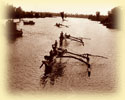|

 |
|
 |
 |
|
Area & population |
65 000 sq.km, 15 million. |
|
Length of coastline |
1 800 km |
|
Shelf area (up to 180m depth) |
31 250 sq km |
|
Strength of fishing fleet |
28 000 craft (including 1 500
multi-day boats) |
|
Traditional craft |
Oru, vallam, theppam, kattumaram. |
|
Fishing methods |
Drift gillnetting, longlining,
trawling, line fishing, trolling, beach seining |
|
National fish production |
304 380mt (2000)(marine 267 680 mt,
inland 29 730 mt, aquaculture 6 970 mt) |
|
Fisherfolk population |
150 000 |
|
Related occupations |
50 000 |
|
Maximum sustainable yield |
250 000 mt (170 000 mt pelagic, 80
000 mt demersal) |
|
Pelagic species |
sardine, scad, mackerel, anchovy,
seer fish, tuna |
|
Demersal species |
Bream, snappers, groupers. |
|
Exports |
Rs 10 328 million (2000) |
|
Imports |
Rs 4 951 million |
|
|
Fishing and fish production are vital to the Sri Lankan economy in terms of employment, food and nutrition security and foreign exchange earnings. Over 700 000 people depend on fisheries for their livelihood. The per capita consumption of fish is around 16 kg.
Sri Lanka's continental shelf area is estimated at 31 250 sq. km but its width varies. Most of the fish resources are found within the continental shelf. The 1 800 km-long coastline comprises a vast area of marine habitat - sandy beaches, extensive lagoons, mangroves and coastal marshes. Over 50 per cent of the population resides in the coastal areas of the country.
Of the island's 28 000 craft, some 46 per cent are motorised. The main fishing method is drift gill netting, which accounts for about 60 per cent of the total catch. Long-lining, trawling, line fishing, trolling and beach seining are the other important types of fishing. Some 1 500 multi-day boats operate in the offshore/ oceanic area. Presently, over 75 per cent of the multi-day boats are equipped with SSB radio, and satellite navigators have been provided under various government development schemes.
Fisheries in the island can be broadly divided into four categories - coastal or inshore fisheries, offshore or deep-sea fisheries, inland fisheries and coastal aquaculture. Fisheries on the shelf are supported by a wide range of coastal pelagic and demersal species, typical of tropical multi-species fisheries.
The maximum sustainable yield (MSY) of the coastal marine resources in Sri Lanka was estimated in 1979-1980 at about 250 000 metric tonnes (mt), of which up to 170 000 mt were pelagic fish (small and medium-sized sardine, scad, mackerel, anchovy, seer fish and tuna) and up to 80 000 mt were demersal or semi-demersal (bream, snappers, groupers, etc). Fisheries in the offshore or deep-sea waters are supported by medium-sized and large pelagics, mainly tuna, and an exotic range of deep-water demersal species.
There has been a marked increase in fish production from offshore or deep-sea areas owing to the introduction of better-equipped multi-day boats. The production from the offshore and deep-sea sector increased from 800 mt in 1972 to 84 400 mt in 2000. Coastal aquaculture in Sri Lanka is presently confined to shrimp farming in the north-western province and a National Aquaculture Development Authority has been set up in the country to regulate shrimp aquaculture.
The ornamental fish trade in Sri Lanka has developed into a valuable foreign exchange earner. Sixty fresh water species and over 200 marine species are collected and exported to over 25 countries. However, management measures are urgent for the sustainability of the aquarium industry.
The export of fish and fish products is an important source of foreign exchange. However, Sri Lanka is a net importer of fish. With high per capita consumption, demand exceeds supply. Fish imports consisted mainly of dried and canned fish. They amounted to 77 338 mt, valued at Rs 4 951 million.
A new Fisheries and Aquatic Resources Act was promulgated by Sri Lanka in 1996, following clear evidence that coastal fishing exceeded sustainable limits. This Act lays greater emphasis on management and sustainable development of fisheries through 10 sections that address (i) Licensing of all major fishing operations, (ii) Declaration of areas for fisheries management and (iii) Conservation of fisheries and aquatic resources. |
|
|

Click
on the Image to ENLARGE

(pdf 2.2MB size)

(pdf 1.2MB size)

|